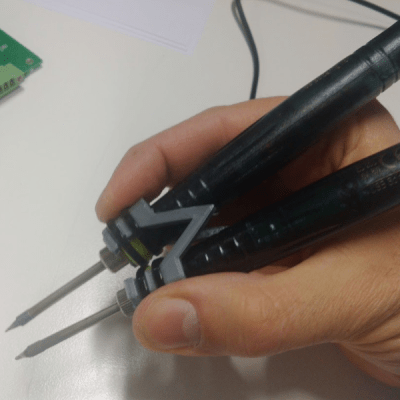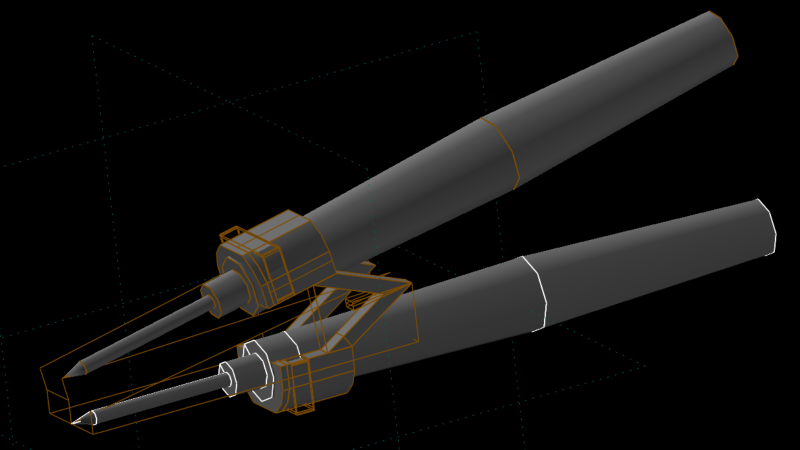This is 2016, and almost every hacker dabbles with SMD parts now, unlike back in the day. This means investing in at least some specialized tools and equipment to make the job easier. One handy tool is the SMD soldering tweezers – useful not only for manual soldering of parts, but also for de-soldering them quickly and without causing damage to the part or the board. Often, especially when repairing stuff, using a hot air gun can get tricky if you want to remove just one tiny part.
 [adria.junyent-ferre] took a pair of cheap £5 USB soldering irons and turned them into a nifty pair of SMD soldering tweezers. The two irons are coupled together using a simple, 3D printed part. [adria]’s been through a couple of iterations, so the final version ought to work quite well. The video after the break shows him quickly de-soldering a bunch of 0805 SMD resistors in quick succession.
[adria.junyent-ferre] took a pair of cheap £5 USB soldering irons and turned them into a nifty pair of SMD soldering tweezers. The two irons are coupled together using a simple, 3D printed part. [adria]’s been through a couple of iterations, so the final version ought to work quite well. The video after the break shows him quickly de-soldering a bunch of 0805 SMD resistors in quick succession.
Earlier this year, we had posted [BigClive]’s tear down of these 8 watt USB soldering irons which turned out to be surprisingly capable and this spurred [adria] to order a couple to try them out.
The 3D printed part is modeled in SolveSpace – a parametric 2D and 3D CAD software that we blogged about a while ago.
[wpvideo Bacqy7VH]















Very cool project, I need to order a second one of these usb soldering irons.
Why didn’t you already buy several, to keep one in each of your many tool kits? ;-P
I always carry one around in my backpack… But I have ordered two now :-)
Meh! I ordered one, and just could not get it to work at all.
It lights up, but if I touch the nub, nothing happens. Also, using a USB power monitor device, I see that there is minimal current drawn, indicating that the iron is not even trying to heat up. :-(
Any suggestions?
unscrew the tip’s retaining ring and reseat the tip, its fully removeable
I think you are right, soldering iron’s are very simple in design. There is not much that can go wrong with them. I think it will be the tip too. either that or a loose connection.
These ones are power from USB straightaway, they have all the circuitry in the iron itself rather than being hooked to a soldering station. Therefore, there’s quite a pile of things that can be wrong inside the device.
I was tempted to say “have you tried turning it on and off again?” but that only worked in PCs.
There really isn’t anything fancy going on other than the on/timeout circuit, so if the led is on the tip should be on – there is no regulation just a ‘FET connecting the tip to USB. I bought one after seeing Big Clive do a teardown, then I bought a handful to have in every toolkit/travel case when it worked so well after I tried the 1
https://www.youtube.com/watch?v=o-8D5t6TJYU
I have one of these for over a year already, the soldering iron itself is identical, but instead of a USB connector, it seems to use an audio jack, and it connects to a “computer mouse” with a variable temperature scroll wheel, and I noticed its working/failing systematically depends on what kind of socket (and on what floor) the “mouse” wal-wart is connected to: i.e. some sockets it works flawlessly, other sockets it refuses to work except for once every 5 minutes of fiddling with all the connection, touching/releasing the capacitive sensor only to get one period of heating from the 555. I don’t know to what extent the designers relied on exact science or trial and error, until it worked in their lab, or similar environments sometimes I think the capacitive sensing is influenced by the earthing system. But when it does work it works continuously I’m pretty happy with it, especially for fine circuitry. I’ll have to try one of those USB powerbanks…
The irons i ordered were always fiddly like that so i added a ball bearing next to the capacitive tip and connected it to the usb ground. When i press my finger it bridges between the bearing and the contact. Seems to trigger it every time now
Mine are all the same, and the male part of the jack has a wide flat rim where the female jack on the iron is slightly inset so the cable always pops out easily, so I shave all the male sides’ base down to a taper. As far as the touch sensor; yes that also super finicky. They also have a vibration switch which works better by tapping the iron. Some of the irons I just took apart and shorted out the vibration switch to stay on constantly when plugged in
I see a problem with smaller components – I don’t use 1206 regularly, more like 0603. The thick straight tips of the irons will not close enough for small components.
The Solvespace model can be adjusted to take that into account. Place the two irons a bit further from each other and let the distance in idle state be smaller and bob’s your uncle. I’ve noticed some commercial tweezers have the same issue: when you press them shut there’s still gap between the tips.
I ordered last weekend when someone sent me a link to the project page. I can’t play the video and can’t find an alternate location.
I found videos on the single irons.
https://www.youtube.com/watch?v=LcJv2d5S4a8
I was not able to get the video to play.
It just sits there. and Im its starting to suck me into the black void…….
You might have to clear the cache and reload the page. Sometimes weird stuff happens to the page on mobile and the videos seem to be the first to glitch.
I’m not on mobile but I have trouble believing that three different desktop browsers just need to have their cache flushed to play that video properly. Which I just did to each, to no avail.
I move that it’s either a bad or down video service or maybe a misconfigured embedded link.
Close your eyes and imagine a guy using a pair of home made soldering tweezers. No need to flush your cache.
hah yeah. I got sidetracked trying to fix the problem I didn’t stop to think if it was going to be worth it.
Is there a link to the 3D printable file?
Thanks
Sally
Hi, There is a project in Hackaday.io https://hackaday.io/project/18706-cheap-smd-soldering-tweezers-from-ebay ;)
Enjoy
Awesome – thank you for the link